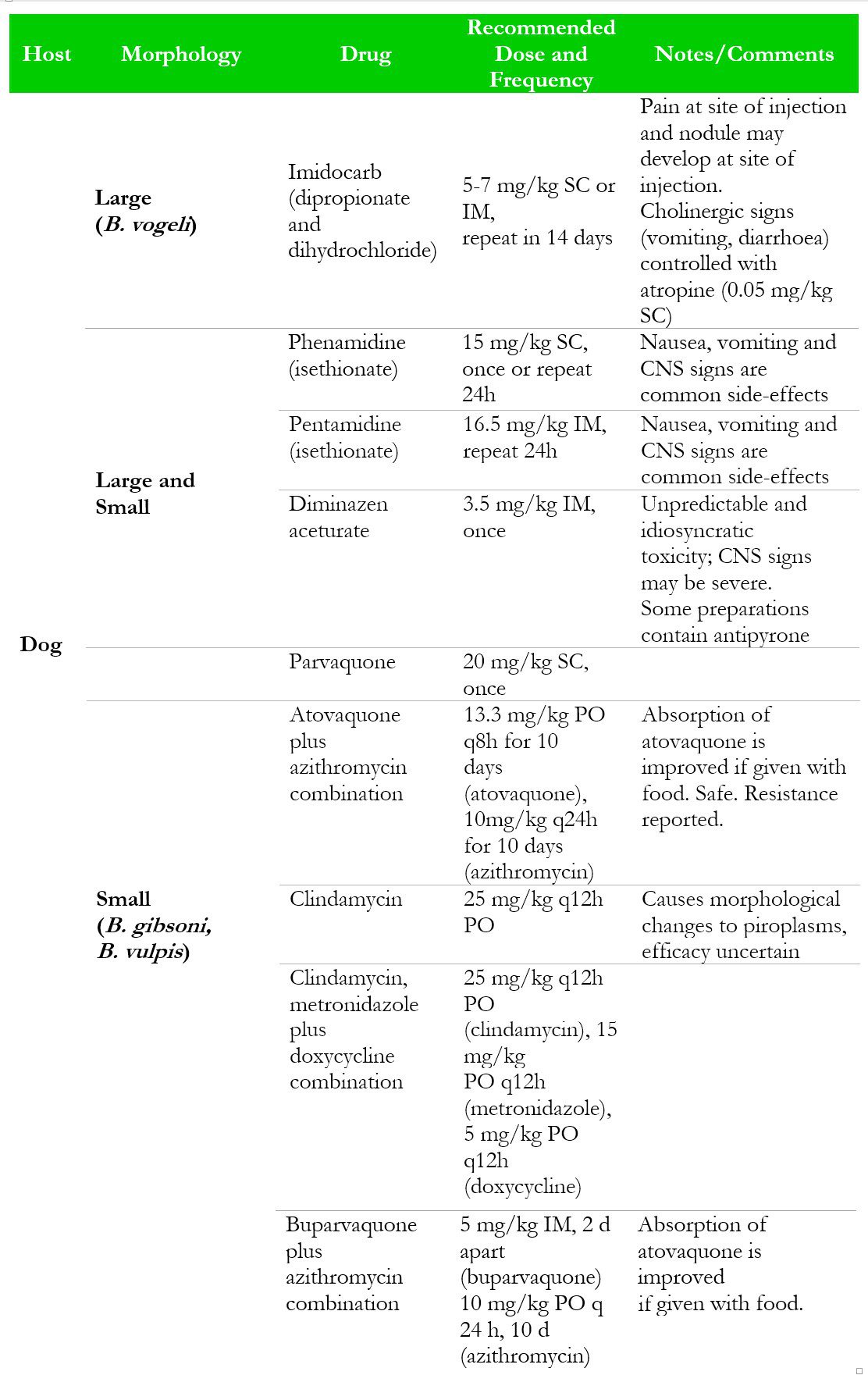
Babesiosis in dogs: treatment
For the treatment of dogs suffering from babesiosis, a large number of different drugs have been tested with different results.

However, diamidine derivatives used for the treatment of canine babesiosis (berenil, batryzin, verbiben, azidin, etc.) have a wide practical application. The active ingredient of these drugs is diminazene aceturate. Azidine contains 100% active ingredient. Berenil is produced in the form of granules, 23,6 g of which contains 10,5 g of the active substance. Batrizin is produced in the form of granules, 10,5 g of which contains 4,66 g of the active substance. Veriben is produced in the form of granules, 2,36 g of which contains 1,05 g of the active substance. Azidine, berenil and batryzine belong to group “B” in terms of toxicity. The maximum tolerated dose of drugs for mice is 40 mg / kg, for rabbits – 25-30 mg / kg, dogs, cattle and horses – 10 mg / kg. The drugs do not have a pronounced cumulative effect, but in high doses they cause poisoning, characterized by a disorder in the activity of the central nervous system: tonic convulsions, ataxia, and sometimes vomiting. Veriben belongs to compounds that are moderately toxic for warm-blooded animals. The drug accumulates mainly in the liver and kidneys, in small amounts in the brain and is excreted mainly in the urine. The action of the drugs is based on the inhibition of aerobic glycolysis and DNA synthesis in pathogenic protozoa, the effect on the fine structure and function of cell membranes. Individual resistance parasites to berenil is a decisive factor in the survival of individual organisms. The second derivative of diamidine, which is effective both against B. canis, and other types of diseases – pentamidine, is used at a dose of 16,5 mg / kg twice with a daily interval. With its use, side effects such as pain at the injection site, tachycardia, nausea and vomiting are possible. A highly effective drug against B. canis is imidocarb (a derivative of carbanilide) used at a dose of 5 mg/kg. According to some authors, berenyl and azidine sterilize the body of animals from piroplasmids and prevent babesiosis when administered 5-10 and even 17 days before infection. According to D.A. Strashnova (1975), berenil at a dose of 7 mg/kg of body weight prevents infection of dogs with pathogen B. canis within 15 days. However, the administration of berenyl for prophylactic purposes simultaneously with invading blood did not sterilize the body of dogs from B. canis, but, nevertheless, the multiplication of the pathogen in the blood is sharply reduced. To reduce the pathological impact as a result of the vital activity of parasites and their mass death after the administration of anti-baby drugs, as well as to reduce the toxic effects of protistocidal drugs, various symptomatic therapy should be used. For to improve cardiac activity, various cardiac preparations are used. Most often, sulfocamphocaine is used in the form of a 10% solution subcutaneously or intramuscularly at a dose of 1,0 ml per 20 kg of the dog’s live weight. The drug is administered 1-2 times during the entire course of treatment. Other cardiac remedies (riboxin, cordiamin, camphor) are also used. To relieve general intoxication, the drug gamavit is used, which contains a physiologically balanced mixture of 20 amino acids, 17 vitamins, nucleic acid fragments, trace elements, as well as placental extract and an immunostimulant (sodium nucleinate). The main indications for the use of gamavit are its properties as a detoxicant, which ensures the neutralization and removal of toxic decay products, and normalizes the functions disturbed as a result of their exposure. Gamavit contributes to the restoration of impaired hematopoietic function in babesiosis. The drug stimulates erythropoiesis, which contributes to the rapid restoration of the number of red blood cells. 9) and L-glutamic acid, is involved in maintaining hematopoiesis. The drug should be administered subcutaneously at a dose of 0,1 ml / kg of body weight for 5-7 days. Quite often, edema of various parts of the body in dogs and hemorrhages on the mucous membranes have a common origin and are due to an increase in vascular porosity as a result of exposure to toxins. To restore the integrity and prevent violations of the vascular walls, etamsylate (dicinone) is used in the form of a 12,5% solution intramuscularly. The drug is administered at a dose of 1,0 ml per 20 kg of body weight once a day for the first 2-3 days of treatment. Meningeal phenomena registered in some dogs are presumably due to the development of opportunistic microflora due to a decrease in the resistance of the sick animal. Therefore, to prevent the occurrence of this symptom complex, it is necessary to use antimicrobial agents. Based on this, injections of benzylpenicillin sodium salt should be included in the course of treatment for babesiosis to prevent meningeal events in dogs. The drug is administered intramuscularly at a dose of 10-15 thousand units per kg of body weight every 6 hours, starting from the first dose of the animal, throughout the course of treatment. Antihistamines and corticosteroids (dexamethasone, prednisolone) are used to reduce the overall inflammatory response. It is known that long-term use of corticosteroids can cause a violation of water-sodium metabolism in the body or lead to inhibition of the function of the adrenal cortex. Therefore, in order to avoid these phenomena, in the last two days the drug is administered in reduced doses. To maintain liver function in sick dogs, Essentiale forte is also used at a dose of 3-5 ml per animal intravenously for 5-7 days.
See also:
What is babesiosis and where do ixodid ticks live
When can a dog get babesiosis?
Babesiosis in dogs: symptoms
Babesiosis in dogs: diagnosis
Babesiosis in dogs: prevention





